Never has a British sovereign reigned so long. Queen Elizabeth II passed away on Thursday, September 8, 2022. at the age of 96, after 70 years of reign. Ascended to the British throne on February 6, 1952, the monarch saw the birth of nearly 87% of the current population of her country, retained immense popularity despite the crises, visited more than a hundred countries, and knew ten French presidents. Franceinfo summarizes this historical reign in many respects in seven infographics.
>> Follow our live after the death of Queen Elizabeth II
She was queen for over 70 years
Among the current heads of state, Queen Elizabeth II held the record for longevity, ahead of other sovereigns. With more than 70 years of reign, she was far ahead of the Sultan of Brunei, who had been in place for 55 years. The Scandinavian monarchs Margrethe II (Denmark) and Carl XVI Gustaf (Sweden), respectively 50 and 49 years of reign, complete this list of indestructible heads of state.
However, the absolute record of the monarch having reigned the longest does not belong to Elizabeth II. In Europe, Bernard VII reigned over the principality of Lippe (a German state) in the 15th century for 81 years and 7 months. On the French side, Louis XIV also had a slightly longer reign than Queen Elizabeth, since he remained on the throne of France and Navarre for 72 years.
Most Brits have only known her
Another consequence of his great longevity, no Briton under the age of 70 has known another monarch on the throne. This represents almost 87% of the UK population, according to 2018 census figures.
His popularity was at the peak
Her 70-year reign did not appear to have eroded the Queen’s popularity: according to a YouGov poll in the second quarter of the year, 75% of Britons said they had a favorable opinion of Elizabeth II. Its popularity reached 89% among “baby boomers” (people born between the mid-1940s and mid-1960s), but two-thirds of “millennials” (people born in the 1980s and 1990s) had also a good opinion of their sovereign.
The Queen was the most popular member of the royal family, followed by her daughter-in-law Kate Middleton (68% positive opinions) and her husband Prince William (66% positive opinions). Then come the first two children of the Queen: Princess Anne and Prince Charles. Called to succeed his mother, the Prince of Wales only receives 42% positive opinions. Among the less popular members of royalty, Prince Harry and his wife Meghan Markle, who retired from the royal family in 2020, do not receive more than a third of favorable opinions.
His kingdom was bigger than Russia
If Elizabeth II was the queen of the United Kingdom of Great Britain and Northern Ireland, she also reigned over fourteen other sovereign states, members of the Commonwealth. The sovereign was thus the head of state of Canada, Australia, New Zealand, Papua New Guinea or even Belize. The other countries over which she ruled are islands or archipelagos located in the Caribbean or the Pacific Ocean. His kingdom thus extended over more than 18.5 million km 2, more than the area of Russia.
Yet when she ascended the throne in 1952, she ruled over even greater territory. Countries such as Malaysia, Nigeria or Kenya gained their independence in the late 1950s and early 1960s. Other independent nations such as Pakistan or South Africa chose to become republics and therefore no longer consider the Queen of England as their head of state. Barbados is the latest state to do so, at the end of November 2021.
She has seen ten French presidents parade
As a result of her extraordinary longevity, Elizabeth II has seen many foreign heads of state succeed one another. When he came to power in 1952, the United States was led by Harry Truman, the USSR by Joseph Stalin and Spain by Francisco Franco. In France, the head of state was Vincent Auriol, first president of the Fourth Republic.
Since then, ten Presidents of the French Republic have succeeded one another. François Mitterrand and Jacques Chirac, who are the two to have remained in place the longest, respectively 14 and 12 years, are also the only ones to have been both welcomed by the Queen in the United Kingdom (1984 and 1996) and in having received her in France for a State visit (1992 and 2004).
She has visited more than 100 countries
In seven decades of reign, Elizabeth II has had the opportunity to meet many foreign leaders during her 89 state visits. To these are added the more than 170 trips made by the Queen to Commonwealth countries. In total, more than 100 countries have been visited by the Queen during her official trips.
The countries most visited by the monarch are members of the Commonwealth of which she is the sovereign. Canada is thus his favorite destination, with no less than 27 visits, followed by Australia (18 visits) and New Zealand (10 visits). Outside the Commonwealth, the countries with the most state visits from the Queen are France and Germany, with five visits. Elizabeth II visited France in 1957, 1972, 1992, 2004 and 2014.
Prince Charles has waited a long time
Who says 70 years of reign for Elizabeth II, also says 70 years of waiting for Prince Charles, the Queen’s eldest son, born in 1948, four years before she was crowned. Heir to the crown since his mother acceded to the throne, the Prince of Wales has been in this position the longest since the birth of the United Kingdom in the early 18th century.
Prince Charles is ahead of Prince Albert-Edouard, son of Queen Victoria, who reigned for 63 years over the kingdom in the 19th century. And his three longest-serving ancestors (Princes Albert-Edouard, Georges and Edouard) all ended up becoming kings. This will therefore also be the case of Prince Charles, a role for which he has been preparing for… 70 years.
